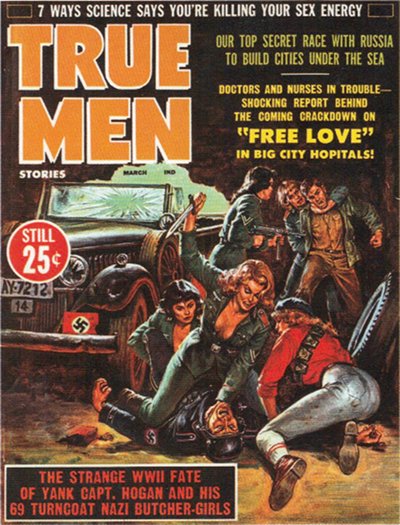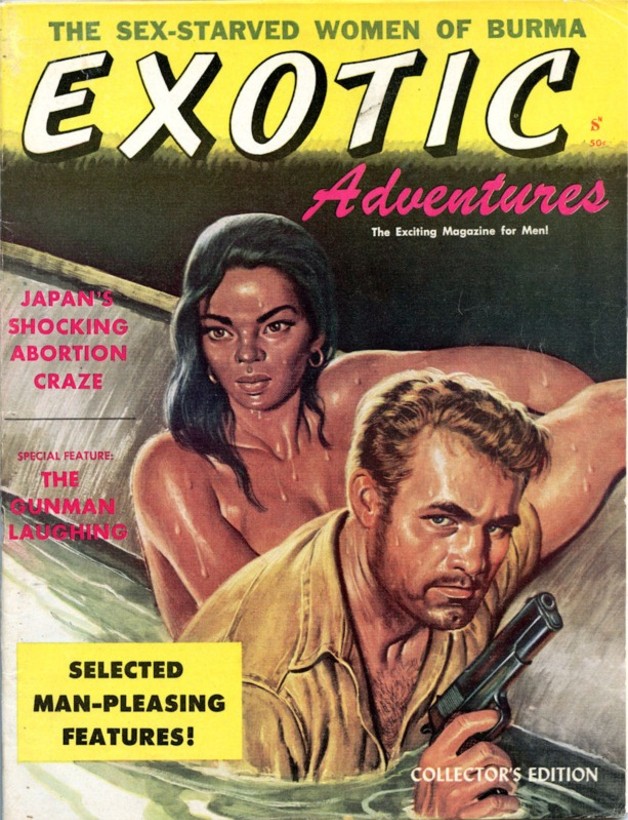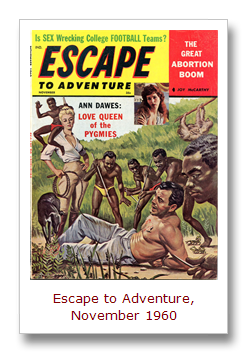Elmer Wheeler was the greatest salesman of his time. He took a wise crack: “Don’t sell the steak, sell the sizzle” and turned it into an imposing, profit-making, money-sucking business philosophy. Wheeler emphasised that people are not interested in “the steak”, the meat of the product or service itself. But people want the “sizzle” – the real main reasons why they want to buy The men’s pulp magazines and adventure magazines of the post WWII era until the late 1960’s pretty well stuck to Wheeler’s manta. The headlines of the magazines were far more lurid and sensational then the actual stories inside the magazine, though the underlying subtext was hardly of the romantic comedy variety that finished on the altar. In fact they resembled populist versions of H.G. Wells and the writings of Charles Darwin…
The popularity of men’s adventure magazines peaked in the late 1950s, when fifty different titles were published and hundreds of thousands of men picked up the magazines at the local drugstore or read them at barbershops. But as Playboy initially, then Penthouse came on the scene,the advent of television, and the courts began liberalizing the ambiguous nature of what was deemed obscene material, these “sweats” began to seem quite tame and outdated in comparison and couldn’t compete. We were now in the era of Lenny Bruce, Hugh Hefner and Allen Ginsberg. The pulps quietly died out by the 1970’s. The themes today are seen in reality survival shows and series such as “lost”, but the medium of delivery could not adjust.

Brett McKay:Products of the time, the magazines were certainly not politically correct. Instead of articles about $10,000 watches and luxury vacations, the pages of the sweat magazines were filled with “true” (typically fictionalized or embellished) stories of war, survival, crime, safari, and the Old West. A favorite theme was the showdown between man and wild flesh-eating beasts and critters. Stories of men rescuing women from the torture of savage natives or cruel enemy armies were common (as were tales of powerful Amazonian-like women and man-capturing gangs of female dominatrices).
“Really, what we see in the men’s adventure mags is the other side of the pressures on women to conform to a social role reflected in the domestic magazines of the day, like Good Housekeeping, etcetera. In both cases, these magazines offered very extreme, very conservative roles for men and women. The most obvious reason for this, at least in the case of the women’s magazines, was a pressure to get women back in the kitchens after their empowering work in factories during World War Two. But it was also the economic and suburban boom that put pressure on having a family in the years after the war….

"Yes. Playboy and the hundreds of bachelor magazines that followed in its wake were all about the fantasy of upwardly mobile bachelorhood, emulating the life of leisure. In contrast, the men’s adventure mags were decidedly blue collar. Whereas the bachelor mags had articles and ads about leisure wear for a summer cruise, the men’s adventure magazines had ads for correspondence schools and offered stories and articles that confirmed masculinity in a different way — not by constructing a fantasy bachelor’s world, but by showing man in perilous and extreme situations, triumphant. And, again, the locals of these were as far away from the pressures of suburbia and the day-to-day job pressures as possible. " ( Earle )
Of course the men’s magazines are very, very extreme in their portrayal of gender roles. Whereas women’s magazines advertised the love of an “all pink” kitchen and men as the master in the house, men’s magazines fought a fear that American suburban culture was too feminine, and was feminizing the men. And while these magazines are incredibly fun, they also often have a really troubling misogyny in them.” (Dr. David M. Earle )

"There’s a subgenre of pre-World War II pulp magazines called “weird menace” which features good-looking women and men being menaced (and often tortured) by evil villains and freaks. There’s a subgenre of the postwar men’s adventure magazines that features good-looking women and men being attacked by vicious animals (including vicious rodents, turtles and aardvarks). Within that animal attack subgenre is a sub-subgenre that I’m hereby dubbing “snake menace” – to describe the many cover paintings and stories that featured scary, menacing snakes." Will Hulsey artwork
The magazines seemed modeled on the H.G. Wells ideas of war between humans and of war between humans and non-humans. They are science fiction without being categorized as Jules Verne worthy;here there is an eternal conflict that mirrors the intellectual and emotional legacy of Well’s work in its contradictory nature. War is repugnant.In “Mr Britling Sees It Through” (1916) there is a fine account of the anguish as experienced by Wells, of the First World War, a conflict in which “our only strategy was to barter blood for blood”. The horror of the waste of youth impels Britling to argue that “there is no chance of bettering life until we have made an end of all that causes war”. In this Wells evidently reflected a public mood in Britain and Germany at the time. But five years later he was still the Darwinian thinker who appeared to believe that peace was impossible between species, and that their competition must result in the extermination of one side or another, without hope of mediation by intelligence. Though there are faint hopes that we can coexist with man and nature, there is a bleak Darwinian perspective that pervades the narrative: “Any intelligent form is its own absolute; and there cannot be two absolutes”: Life as a whole must inevitably be plagued by Darwinian carnage. It is a measure of Wells’s capacity of imagination that his works illuminate both sides of this dismaying contradiction.
Its definitely low brow. But they reflect this Darwin/Wells dynamic of competition between men, between man and beast and the emotionally charged gender conflict from without and within. The fears, fantasies and psychosis represented does an adequate job of mirroring the culture in which it was read. Incredible as it may seems the quality of writing was pretty good; these magazines were often temporary stopping points for writers who went on to great success; no Nobel laureates for literature, but commercial renown.such as Mario Puzo whose “Godfather” is a landmark in Darwin social theory.
Depending on how you categorize certain vintage magazines, roughly 150 different men’s adventure magazines were published during the 1950s, 1960s and 1970s. Categorization can be difficult for various reasons. One is that certain vintage men’s magazines — such as Exotic Adventures — had aspects of both the pulpy adventure-style genre and the men’s girlie “slicks”, or bachelor magazines.However, as in many vintage men’s magazines, the photos are accompanied by some truly cringeworthy text and captions that are either are incredibly inane or incredibly sexist. Or both.Of course, no vintage men’s adventure magazine would be complete without ads that also seem sexist and outdated.

"Some of the men’s adventure magazines had relatively large circulations and production budgets, such as True, Argosy and Stag. But most did not. To fill up an issue, budget-minded editors of many men’s pulp mags would sometimes reuse stories and artwork that had previously appeared in their own magazine or in another magazine owned by the same publishing company. In some cases they bought reprint rights from another publisher, for a fee that was smaller than the cost of buying an original story or artwork. A few fly-by-night
’s pulp magazines simply pirated stuff that had been used in other men’s mags."H.G. Well”s short story In The Abyss (1896), about contact with sea-bed aliens, is an honourable exception to his pattern, although it ends on an ominous note: “It is hardly probable that no further attempt will be made to verify his strange story of these hitherto unsuspected cities of the deep sea.” But consider The First Men in the Moon (1901). This is a story of contact between two intelligent species who actually learn to communicate. But Cavor and Bedford quickly convince the Selenites that they are “strong dangerous animals”, and Bedford, lusting after the “gold knocking about like cast iron at home’ considers ‘coming back in a bigger sphere with guns”. Cavor, though, dreams of tapping Selenite wisdom, and the Selenites learn human speech. But the more the Grand Lunar learns of Earth the more horrified he is by man, who “lives on the mere surface of a world … who cannot even unite to overcome the beasts that prey upon his kind, and yet who dares to invade another planet” . In the end Cavor foolishly convinces the Grand Lunar of humans’ “insatiable aggressions, their tireless futility of conflict” . And, presenting himself as the only way by which man can reach the Moon, Cavor gets himself killed.
Addendum:
Josh Alan Friedman:“My dad hired Mario right out of the Post Office, where he had been working, around 1959. He was there for seven or eight years, until about the time my father left the company in 1966.
My dad always loved him. He was a big, fat guy, and my dad always thought he was a very gifted writer. When he hired him, I think Mario had published or was about to publish his very first novel, called The Dark Arena. He came in and gave it to my dad at the interview and my father loved it and hired him right away.

"The special “book bonus” in this issue — “LOVE-HUNGRY GIRL IN THE ‘BILLION DOLLAR OASIS’” — is by Alan Caillou, the nom de plume of an interesting man who had a long and varied career as an adventurer, novelist, screenwriter and actor. His real name was Alan Samuel Lyle-Smythe. By the time of his death in 2006, he had written dozens of popular novels, at least ten movie screenplays (including William Shatner’s 1977 classic, Kingdom of the Spiders), and scripts for more than 80 episodes of vintage TV shows, including 77 Sunset Strip, The Rat Patrol, It Takes a Thief, The Six Million Dollar Man and The Man from U.N.C.L.E."
When my dad was at Mag Management, they had an extraordinary run of guys who became great writers and screenwriters. At one time, Mickey Spillane worked there. So did Ernest Tidyman, who went on to write The French Connection, and Shaft and High Plains Drifter. Martin Cruz Smith worked there, who wrote Gorky Park. And, many other great writers were stringers [regular contributors] for my dad’s magazines.

"And while these magazines are incredibly fun, they also often have a really troubling misogyny in them. Jem, a bachelor magazine called “the magazine for masterful men,” is perhaps the worse, but some of the adventure mags aren’t too far behind. That’s why there are so many stories in them about dangerous women: the dominatrix female Nazi guards and Amazon women — like the “Love Queen of the Pygmies” story you recently featured on your blog. At the same time, it’s why there are also many stories of women in peril who are helpless or just sex objects, hence having a man save them in the story confirms masculinity." ( Earle )
Mario Puzo became one of my dad’s best friends. He died about ten years ago, and my father still hasn’t gotten over it completely. They were very close.”

"There are a few traditionalists in Hemingway studies who snub it, but that’s because I’m saying pretty controversial stuff, such as Hemingway tried to be a pulp writer before he discovered Modernism at the hands of Gertrude Stein, Ezra Pound, and Sherwood Anderson. Plus I am presenting the popular Hemingway, which has always been opposed to the academic Hemingway. But they’ll come around. I mean, the evidence and fascination of Hemingway in the men’s mags and gossip magazines is incontrovertible. "( Earle )
“The readership largely consisted of GI’s who had fought and survived the Big One, men who had experienced both adventure and gruesome death and violence. In contrast to their experiences overseas, life back home seemed dull and mundane. Their wives and families who hadn’t experienced the horrors of war had only vague notions of what things had been like “over there.” In a life that seemed sterile and scrubbed clean, men’s magazines were an oasis of the kind of unfettered manliness and grit the men were used to. And to the men who hadn’t served, the magazines were a chance to live such adventures vicariously.”
… The clearest expression of Wells’s thinking in this regard may in his story The Grisly Folk’ (1921). The Neanderthal is our closest relative but seems monstrous: “The grisly thing … was hunchbacked and very big and low, a grey hairy wolf-like monster.” Once they have met, conflict between Neanderthals and humans is immediate and relentless – and one-sided: “For the Neandertalers it was the beginning of an incessant war that could end only in extermination … Many and obstinate were the duels and battles these two sorts of men fought for this world in that bleak age of the windy steppes, thirty or forty thousand years ago. The two races were intolerable to each other.” But why intolerable? Because: “They both wanted the caves and the banks by the rivers where the big flints were got. They fought over the dead mammoths that had been bogged in the marshes, and over the reindeer stags that had been killed in the rutting season.” This is not human war. This conflict is Darwinian, between two species competing for the same ecological niche, and so it has a depth and intensity and bleakness of purpose approached only, perhaps, in the Nazis’ systematic assaults on the Jewish, Slavic and other races, whom they regarded, indeed, as belonging to a different species.
Wells had studied evolution under Huxley, Darwin’s follower, and understood this very well. ‘The Grisly Folk’ is like a dramatisation of Darwin’s own writing, for example of this extract from Chapter 3 of On the Origin of Species (1859): “As species of the same genus have usually, though by no means invariably, some similarity in habits and constitution, and always in structure, the struggle will generally be more severe between species of the same genus, when they come into competition with each other, than between species of distinct genera. We see this in the recent extension over parts of the United States of one species of swallow having caused the decrease of another species …” Today we might think of red and grey squirrels. “We can dimly see why the competition should be most severe between allied forms, which fill nearly the same place in the economy of nature; but probably in no one case could we precisely say why one species has been victorious over another in the great battle of life.”

---Wells portrayed conflicts between intelligent species in which there is no attempt to communicate at all. In The Empire of the Ants (1905) an Amazonian village is overwhelmed by a new sort of ant, and evidently an intelligent sort. When they move in the open the ants are in ‘spaced-out lines, oddly suggestive of the rushes of modern infantry advancing under fire’. But there is no attempt at communication. The ants simply overwhelm humans: ‘Their action has been a steady progressive settlement, involving the flight and slaughter of every human being in the new areas they invade.’---
aa






 COMMENTS
COMMENTS